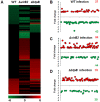Early transcriptional responses of bovine chorioallantoic membrane explants to wild type, ΔvirB2 or ΔbtpB Brucella abortus infection
- PMID: 25259715
- PMCID: PMC4178178
- DOI: 10.1371/journal.pone.0108606
Early transcriptional responses of bovine chorioallantoic membrane explants to wild type, ΔvirB2 or ΔbtpB Brucella abortus infection
Abstract
The pathogenesis of the Brucella-induced inflammatory response in the bovine placenta is not completely understood. In this study we evaluated the role of the B. abortus Type IV secretion system and the anti-inflammatory factor BtpB in early interactions with bovine placental tissues. Transcription profiles of chorioallantoic membrane (CAM) explants inoculated with wild type (strain 2308), ΔvirB2 or ΔbtpB Brucella abortus were compared by microarray analysis at 4 hours post infection. Transcripts with significant variation (>2 fold change; P<0.05) were functionally classified, and transcripts related to defense and inflammation were assessed by quantitative real time RT-PCR. Infection with wild type B. abortus resulted in slightly more genes with decreased than increased transcription levels. Conversely, infection of trophoblastic cells with the ΔvirB2 or the ΔbtpB mutant strains, that lack a functional T4SS or that has impaired inhibition of TLR signaling, respectively, induced more upregulated than downregulated genes. Wild type Brucella abortus impaired transcription of host genes related to immune response when compared to ΔvirB and ΔbtpB mutants. Our findings suggest that proinflammatory genes are negatively modulated in bovine trophoblastic cells at early stages of infection. The virB operon and btpB are directly or indirectly related to modulation of these host genes. These results shed light on the early interactions between B. abortus and placental tissue that ultimately culminate in inflammatory pathology and abortion.
Conflict of interest statement
Figures






Similar articles
-
Proteomic Profile of Brucella abortus-Infected Bovine Chorioallantoic Membrane Explants.PLoS One. 2016 Apr 22;11(4):e0154209. doi: 10.1371/journal.pone.0154209. eCollection 2016. PLoS One. 2016. PMID: 27104343 Free PMC article.
-
The virB-encoded type IV secretion system is critical for establishment of infection and persistence of Brucella ovis infection in mice.Vet Microbiol. 2012 Sep 14;159(1-2):130-40. doi: 10.1016/j.vetmic.2012.03.029. Epub 2012 Mar 27. Vet Microbiol. 2012. PMID: 22483850
-
Modulation of the bovine trophoblastic innate immune response by Brucella abortus.Infect Immun. 2008 May;76(5):1897-907. doi: 10.1128/IAI.01554-07. Epub 2008 Mar 3. Infect Immun. 2008. PMID: 18316388 Free PMC article.
-
Update on the role of innate immune receptors during Brucella abortus infection.Vet Immunol Immunopathol. 2012 Jul 15;148(1-2):129-35. doi: 10.1016/j.vetimm.2011.05.036. Epub 2011 Jun 6. Vet Immunol Immunopathol. 2012. PMID: 21700343 Review.
-
Immune response triggered by Brucella abortus following infection or vaccination.Vaccine. 2015 Jul 17;33(31):3659-66. doi: 10.1016/j.vaccine.2015.05.057. Epub 2015 Jun 3. Vaccine. 2015. PMID: 26048781 Review.
Cited by
-
Proteomic Profile of Brucella abortus-Infected Bovine Chorioallantoic Membrane Explants.PLoS One. 2016 Apr 22;11(4):e0154209. doi: 10.1371/journal.pone.0154209. eCollection 2016. PLoS One. 2016. PMID: 27104343 Free PMC article.
-
Inflammatory Mechanism of Brucella Infection in Placental Trophoblast Cells.Int J Mol Sci. 2022 Nov 2;23(21):13417. doi: 10.3390/ijms232113417. Int J Mol Sci. 2022. PMID: 36362199 Free PMC article. Review.
-
Brucella - Virulence Factors, Pathogenesis and Treatment.Pol J Microbiol. 2018 Jun 30;67(2):151-161. doi: 10.21307/pjm-2018-029. Pol J Microbiol. 2018. PMID: 30015453 Free PMC article. Review.
-
Immune Responses Potentially Involved in the Gestational Complications of Brucella Infection.Pathogens. 2023 Dec 14;12(12):1450. doi: 10.3390/pathogens12121450. Pathogens. 2023. PMID: 38133333 Free PMC article. Review.
-
Guanylate-binding protein 5 licenses caspase-11 for Gasdermin-D mediated host resistance to Brucella abortus infection.PLoS Pathog. 2018 Dec 27;14(12):e1007519. doi: 10.1371/journal.ppat.1007519. eCollection 2018 Dec. PLoS Pathog. 2018. PMID: 30589883 Free PMC article.
References
-
- Boschiroli ML, Foulongne V, O'Callaghan D (2001) Brucellosis: a worldwide zoonosis. Curr Opin Microbiol 4: 58–64. - PubMed
-
- Cutler SJ, Whatmore AM, Commander NJ (2005) Brucellosis - new aspects of an old disease. J Appl Microbiol 98: 1270–1281. - PubMed
-
- Santos RL, Martins TM, Borges ÁM, Paixão TA (2013) Economic losses due to bovine brucellosis in Brazil. Pesq Vet Bras 33: 759–764.
-
- Samartino LE, Enright FM (1993) Pathogenesis of abortion of bovine brucellosis. Comp Immunol Microbiol Infect Dis 16: 95–101. - PubMed
-
- Acha PN, Szyfres B (2003) Zoonoses and communicable diseases common to man and animals. 3rd ed. Washington: Pan American Health Organization, 3v. (Scientific and Technical Publication, 580).
Publication types
MeSH terms
Grants and funding
LinkOut - more resources
Full Text Sources
Other Literature Sources

